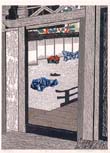|
|
|
|
|
|
|
|
|
|
|
|
|
|
|
|
|
|
|

|
Current Exhibitions Future Exhibitions Back to Exhibitions  |
Flat Surface with Artistic Depth: Three Hundred Years of Japanese Prints March 16–June 10, 2001 Flat Surface with Artistic Depth: Three Centuries of Japanese Woodblock Prints was curated by Kentaro Tomio and is a selection of thirty-three works from several artistic schools of Japanese printmakers. The art of making woodblock prints goes back to the beginnings of Japanese Buddhist culture in the 7th century. To create a woodblock print, the image is first drawn on a block of wood. All the areas that are not meant to print are then cut and gouged out of the wood so that only the image stands out in relief. The block is then inked and paper is placed on the block and rubbed to transfer the ink. Color woodblock prints are made by drawing the image on the same number of blocks of wood as there will be colors on the print. Each block of wood is then cut with areas raised only for that particular color. Each block is then inked and applied to the paper to create only that part of the overall image which is to appear in that color. Each color block must be lined up carefully on the paper so that there is no unintentional overlapping of colors on the finished print. This very exacting process is called registration. Japanese woodblock prints of the Edo period (1615-1868) portrayed images of popular culture and were intended for the common people. They depicted popular actors, beautiful women, famous sites, legends, and events in history to fulfill the role of what we would today call visual media. The artistic school that developed the print into a major art form was the ukiyo-e school. During the Edo period, ukiyo was used to describe the floating world of pleasure and amusement, and the prints often featured beautiful women, handsome men, and Kabuki actors. The letter e, which means painting, was added to the term around 1680, and from then on ukiyo-e was the term used to describe a school of genre painting and printmaking that flourished for 200 years - between 1680 and 1880. These prints were also a distinct art form that was appreciated and adapted by European artists in the second half of the nineteenth century. Among others, the French Impressionists were fascinated by the flatness of surface achieved by using large areas of single color, or by taking unusually high or low perspectives to bring foreground and background towards the same picture plane. Hidden beneath the flat surfaces of the prints were innovative artistic principles. The prints in this exhibit show these and other characteristics of the medium. It is interesting to see how the modern prints included in the exhibit follow, and sometimes struggle with, the artistic principles of the Japanese woodblock prints from the Edo period. The exhibition is free and open to the public. A voluntary admission fee of $3.50 for adults, $1.50 for seniors and children is appreciated and helps fund Museum programs and exhibitions. The Tyler Museum of Art is located on the east side of the Tyler Junior College campus at 1300 S. Mahon. Museum hours are 10:00 a.m. until 5:00 p.m. Tuesday through Saturday and 1:00 p.m. until 5:00 p.m. Sunday. The Museum is closed Mondays. |